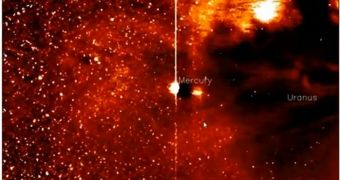As the video embedded at the end of this article will confirm, a skywatcher recently discovered an interesting object near Mercury, apparently moving in the same direction as the planet itself. The unidentified object might very well be an UFO, or it could be a light artifact.
YouTube user siniXster says that the video was recorded from a website operated by the Sun Earth Connection Coronal and Heliospheric Investigation (SECCHI) project. The later is operated by the US Navy Research Laboratory (NRL).
The video clearly shows the wave front of a coronal mass ejection (CME) making its way towards Mercury. Just before hitting the planet, the high-energy particle waves slam into an object that is only then made apparent, as if it were cloaked before.
This is the main assumption that xiniXster makes in presenting the video – that the object is artificial and that it is purposefully hidden. Judging by its relative size when compared to Mercury, the UFO would be extremely large.
In the video, the area where skywatcher and UFO enthusiasts claim a spaceship is parked flares up when hit by radiations. Proponents of this idea say that this is what you could expect to see when a large amount of plasma and energy washes over a cloaked spacecraft.
However, not everyone is convinced that the data are real. Space contacted experts at the NRL, and asked them about what the flare-up could mean. After analyzing the images, the team said that the brightness could very well be a light artifact from the Heliospheric Imager-1 (HI-1) camera.
In other words, it could be that the flare-up was in fact residual light from Mercury, appearing at the spot where the innermost planet had been the day before. The NRL team explained that the artifact may have been produced by light subtraction and enhancement.
The former is a process through which background light is identified, and then removed from an image, so that objects in the foreground have more contrast. Whatever light remains is then enhanced.
Both these techniques are applied to Mercury every day, and it could be that the flare-up was produced by residual light from the previous day.
“When [this] is done between the previous day and the current day and there is a feature like a planet, this introduces dark (negative) artifacts in the background where the planet was on the previous day, which then show up as bright areas in the enhanced image,” Nathan Rich says.
The expert holds an appointment as the NRL SECCHI lead ground systems engineer.

 14 DAY TRIAL //
14 DAY TRIAL // 